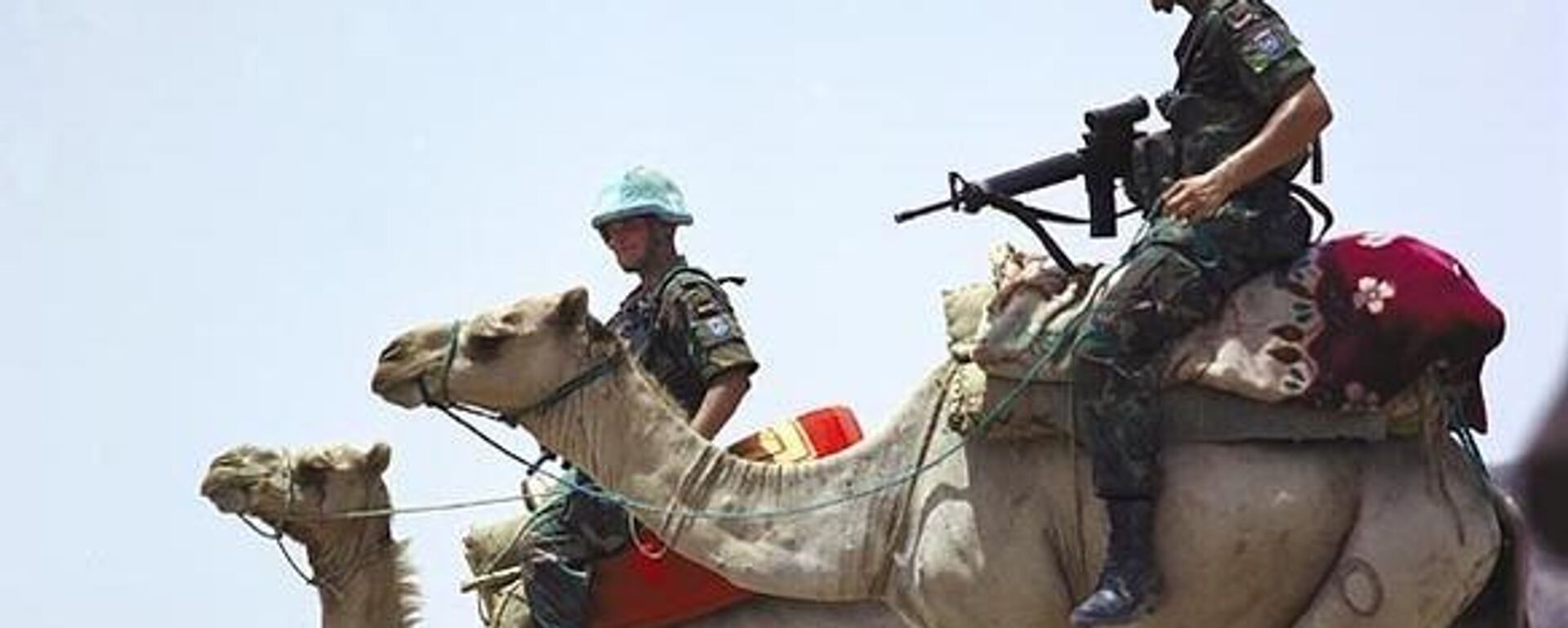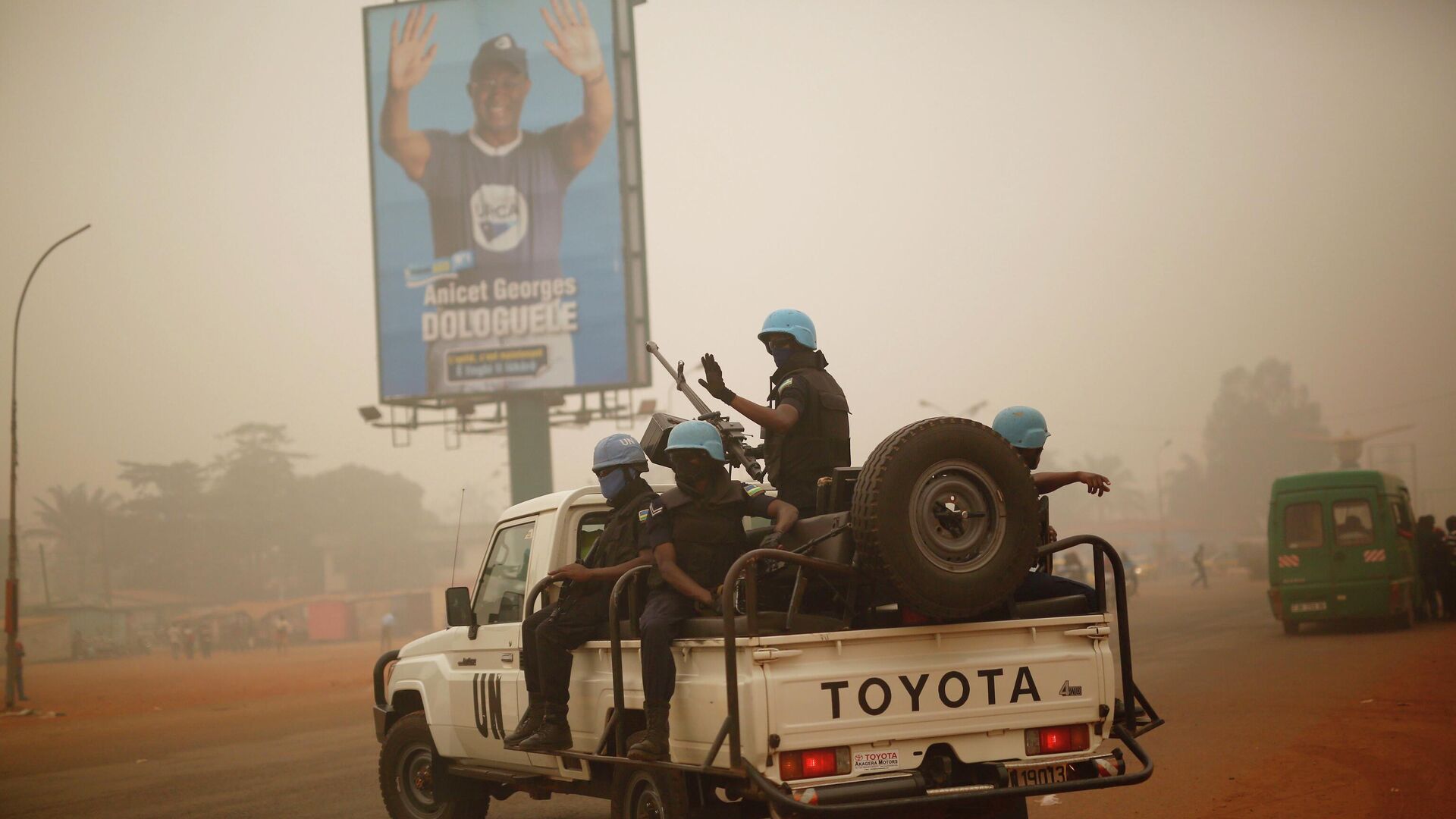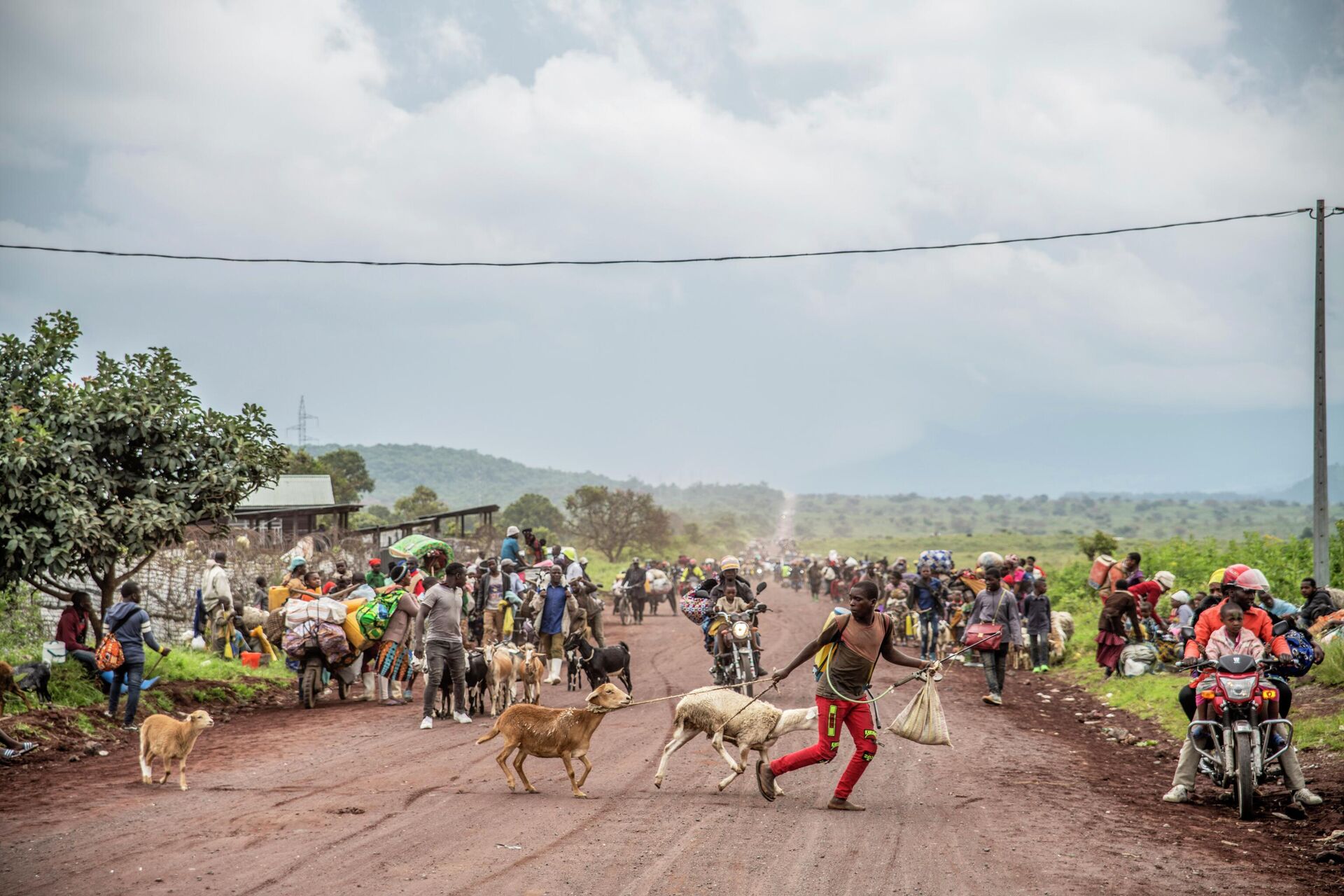https://sputnikglobe.com/20221102/why-un-peacekeeping-in-africa-keeps-facing-obstacles-1102943326.html
Why UN Peacekeeping in Africa Keeps Facing Obstacles
Why UN Peacekeeping in Africa Keeps Facing Obstacles
Sputnik International
UN peacekeepers are the second-largest military force deployed abroad after the US military. However, the outcomes of the activities of "the blue helmets" often show their inefficency, of which African cases are a good example.
2022-11-02T15:54+0000
2022-11-02T15:54+0000
2022-11-24T11:15+0000
africa
the united nations (un)
peacekeeping
war
democratic republic of the congo
rwanda
somalia
sudan
south sudan
https://cdn1.img.sputnikglobe.com/img/07e6/0b/02/1103020132_0:51:3072:1779_1920x0_80_0_0_45c6d7647c91063f9208ebd1df887f8d.jpg
In late October, UN peacekeepers "made a strategic and tactical withdrawal" from a military base in the Democratic Republic of the Congo, losing ground to the M23 rebel group, which the peacekeeper troops were fighting in support of the Congolese government. The retreat is a major setback for the DRC forces and signifies the end to a period of relative peace in the east of the country.Africa has long been one of the regions most troubled by civil and international armed conflicts. In response to this challenge, the UN has launched multiple peacekeeping missions all over the continent. Unfortunately, with the peacekeepers being unable to prevent genocides and sometimes being accused of sexual violence (as for example in the Central African Republic in 2021), the organization's work in Africa has wound up being one of the most obvious signs of a crisis in peacekeeping. Over the last 30 years, there have been numerous cases of tragic failures of "the blue helmets."1. UNOSOM I, UNITAF, and UNOSOM II (1992–1995), Somali Civil WarIn 1991, the dictator Mohamed Siad Barre fell as a result of the Somali Rebellion. Ever since, Somalia has been in the throes of an inter-clan civil war. It soon became obvious that the conflict was severely endangering approximately a half of the country's population, which was around 10 million people in 1991. With the support of all rivaling factions, a UN peacekeeping mission was established as part of a program called United Nations Operation in Somalia I (UNOSOM I). The mission's goals were to uphold a ceasefire and assist humanitarian efforts.In reality, however, the mission was unable to contain ceasefire violations and was soon transformed into the Unified Task Force (UNITAF) and later UNOSOM II. This included the deployment of an international force as large as 22,000 troops and 8,000 civilian specialists to establish a secure environment for humanitarian operations.However, a growing conflict with Mohamed Farah Aidid, the leader of the Somali National Alliance faction, and attempts by the international forces to apprehend him resulted in what became known as the 1993 Battle of Mogadishu, in which 18 American troops were killed and 73 wounded. The incident led to the US withdrawal from Somalia, with the subsequent end of UNOSOM II.With the mission unable to change the course of the conflict, which has been ongoing for upwards of 30 years, the initial enthusiasm for developing UN peacekeeping operations, which became institutionalized after the end of the Cold War, faltered.2. UNAMIR (1993–1996), Rwandan Civil WarAn even more notorious case is the Rwandan Civil War (1990–1994). The conflict between two ethno-social groups, the Hutus and Tutsis, which had been ongoing since the country's independence led to a war in 1990 that resulted in one of the worst ethnic genocides since World War II, with between 500,000 and 662,000 Tutsis and members of other groups killed.The United Nations Assistance Mission for Rwanda (UNAMIR) was established in 1993 to support the implementation of the Arusha Accords that were supposed to bring an end to the conflict. When the genocide broke out in the first half of 1994, the mission was unable to intervene militarily due to its mandate type. Belgium, one of the main contributors of troops to the mission, withdrew its forces after 10 of its soldiers were killed.By the end of spring, the UN recognized that "acts of genocide may have been committed". This led to an expansion of the contingent, which stayed until 1996 to assist in maintaining stability after the end of the genocide under the leadership of pro-Tutsi party the Rwandan Patriotic Front.3. UNAMID (2007–2020), Darfur Conflict in SudanThe activities of the largest peacekeeping mission to date and the first joint peacekeeping force of the United Nations and the African Union saw the UN being accused of learning little from the Rwandan genocide.A bloody conflict broke out in the Darfur region of Sudan in 2003, when non-Arab farmers rose up against Khartoum, which they accused of discrimination. In 2006, after the AU peacekeeping mission, which had no right to carry out a military intervention, proved unsuccessful, the African Union-United Nations Hybrid Operation (UNAMID) was initiated with a contingent of 19,555 military personnel and 3,772 police officers, tasked with stabilizing the situation in Darfur during the final stages of what was considered a peace process. The mission's mandate allowed the troops to use force to protect civilians and humanitarian operations.However, the peace process was sabotaged, and the peacekeeping mission was met with stark opposition from the Sudanese government. The conflict led to around 200,000 people being killed and over 2.5 million displaced.After the US Donald Trump administration proposed reducing the UN peacekeeping budget in 2017, the UNAMID mission was gradually drawn down until its final withdrawal in 2020, with the Darfur conflict still ongoing.4. UNMISS (2011–Today), South Sudanese Civil WarThe United Nations Mission in South Sudan (UNMISS) began shortly after the country's independence in 2011 with the goal of providing "support for peace consolidation and thereby fostering longer-term statebuilding and economic development." However, two years after the initiation of the peacekeeping project, a civil war broke out between the Dinka and Nuer ethnic groups.Over the years, the UNMISS contingent has been expanded. As of 2021, it includes 14,222 military personnel, 1,446 police, and 2,228 civilian workers. The war, which led to at least 382,000 deaths, ended in 2020, with the mission continuing to operate until this day in order to maintain peace.There are several factors that led to the inefficiency of and sometimes even harm being caused by UN peacekeeping missions. In some cases, the contingents were not large enough to make a difference; while sometimes it was a lack of strategy that rendered a mission ineffective. The complicated legal status of a peacekeeper makes it difficult to prosecute them for wrongdoing. Most importantly, the full power of UN missions based on Chapters VI and VII of the United Nations Charter are insufficient to prevent a war or bringing an end to it. Designated with protecting civilians and humanitarian programs, peacekeeping missions should come in conjunction with strong diplomatic actions that take a troubled region's particularities into account.
https://sputnikglobe.com/20221018/as-un-backs-african-unions-ethiopia-ceasefire-call-could-a-peacekeeping-mission-help-1102017232.html
africa
democratic republic of the congo
rwanda
somalia
sudan
south sudan
Sputnik International
feedback@sputniknews.com
+74956456601
MIA „Rossiya Segodnya“
2022
News
en_EN
Sputnik International
feedback@sputniknews.com
+74956456601
MIA „Rossiya Segodnya“
Sputnik International
feedback@sputniknews.com
+74956456601
MIA „Rossiya Segodnya“
why do un peacekeepers fail, peacekeeping in africa, peacekeepers in drc, civil war, civil wars in africa, genocide in rwanda, unamid, unamir, unosom, unitaf, unmiss, unitaf
why do un peacekeepers fail, peacekeeping in africa, peacekeepers in drc, civil war, civil wars in africa, genocide in rwanda, unamid, unamir, unosom, unitaf, unmiss, unitaf
Why UN Peacekeeping in Africa Keeps Facing Obstacles
15:54 GMT 02.11.2022 (Updated: 11:15 GMT 24.11.2022) UN peacekeepers have a contingent of more than 78,000 soldiers and 25,000 civilians scattered across 14 countries. They are the second-largest military force deployed abroad after the US military. However, the outcomes of the activities of the "blue helmets" often show their inefficiency, which cases in Africa serve as good examples of.
In late October, UN peacekeepers "made a strategic and tactical withdrawal" from a military base in the
Democratic Republic of the Congo, losing ground to the M23 rebel group, which the peacekeeper troops were fighting in support of the Congolese government. The retreat is a major setback for the DRC forces and signifies the end to a period of relative peace in the east of the country.
Africa has long been one of the regions most troubled by civil and international armed conflicts. In response to this challenge, the UN has launched multiple peacekeeping missions all over the continent. Unfortunately, with the peacekeepers being unable to prevent genocides and sometimes being accused of sexual violence (as for example in the Central African Republic in 2021), the organization's work in Africa has wound up being one of the most obvious signs of a crisis in peacekeeping.
Over the last 30 years, there have been numerous cases of tragic failures of "the blue helmets."
1. UNOSOM I, UNITAF, and UNOSOM II (1992–1995), Somali Civil War
In 1991, the dictator Mohamed Siad Barre fell as a result of the Somali Rebellion. Ever since,
Somalia has been in the throes of an inter-clan civil war. It soon became obvious that the conflict was severely endangering approximately a half of the country's population, which was around 10 million people in 1991. With the support of all rivaling factions, a UN peacekeeping mission was established as part of a program called
United Nations Operation in Somalia I (UNOSOM I). The mission's goals were to uphold a ceasefire and assist humanitarian efforts.
In reality, however, the mission was unable to contain ceasefire violations and was soon transformed into the Unified Task Force (UNITAF) and later UNOSOM II. This included the deployment of an international force as large as 22,000 troops and 8,000 civilian specialists to establish a secure environment for humanitarian operations.
However, a growing conflict with Mohamed Farah Aidid, the leader of the Somali National Alliance faction, and attempts by the international forces to apprehend him resulted in what became known as the 1993 Battle of Mogadishu, in which 18 American troops were killed and 73 wounded. The incident led to the US withdrawal from Somalia, with the subsequent end of UNOSOM II.
With the mission unable to change the course of the conflict, which has been ongoing for upwards of 30 years, the initial enthusiasm for developing UN peacekeeping operations, which became institutionalized after the end of the Cold War, faltered.
2. UNAMIR (1993–1996), Rwandan Civil War
An even more notorious case is the Rwandan Civil War (1990–1994). The conflict between two ethno-social groups, the Hutus and Tutsis, which had been ongoing since the country's independence led to a war in 1990 that resulted in one of the worst ethnic genocides since World War II, with between 500,000 and 662,000 Tutsis and members of other groups killed.
The United Nations Assistance Mission for Rwanda (UNAMIR) was established in 1993 to support the implementation of the Arusha Accords that were supposed to bring an end to the conflict. When the genocide broke out in the first half of 1994, the mission was unable to intervene militarily due to its mandate type. Belgium, one of the main contributors of troops to the mission, withdrew its forces after 10 of its soldiers were killed.
By the end of spring, the UN recognized that "acts of genocide may have been committed". This led to an expansion of the contingent, which stayed until 1996 to assist in maintaining stability after the end of the genocide under the leadership of pro-Tutsi party the Rwandan Patriotic Front.
3. UNAMID (2007–2020), Darfur Conflict in Sudan
The activities of the largest peacekeeping mission to date and the first joint peacekeeping force of the United Nations and the African Union saw the UN being accused of learning little from the Rwandan genocide.
A bloody conflict broke out in the Darfur region of
Sudan in 2003, when non-Arab farmers rose up against Khartoum, which they accused of discrimination. In 2006, after the AU peacekeeping mission, which had no right to carry out a military intervention, proved unsuccessful, the
African Union-United Nations Hybrid Operation (UNAMID) was initiated with a contingent of 19,555 military personnel and 3,772 police officers, tasked with stabilizing the situation in Darfur during the final stages of what was considered a peace process. The mission's mandate allowed the troops to use force to protect civilians and humanitarian operations.
However, the peace process was sabotaged, and the peacekeeping mission was met with stark opposition from the Sudanese government. The conflict led to around 200,000 people being killed and over 2.5 million displaced.
After the US Donald Trump administration proposed reducing the UN peacekeeping budget in 2017, the UNAMID mission was gradually drawn down until its final withdrawal in 2020, with the Darfur conflict still ongoing.

18 October 2022, 16:16 GMT
4. UNMISS (2011–Today), South Sudanese Civil War
The United Nations Mission in South Sudan (UNMISS) began shortly after the country's independence in 2011 with the goal of providing "
support for peace consolidation and thereby fostering longer-term statebuilding and economic development." However, two years after the initiation of the peacekeeping project, a civil war broke out between the Dinka and Nuer ethnic groups.
Over the years, the UNMISS contingent has been expanded. As of 2021, it includes 14,222 military personnel, 1,446 police, and 2,228 civilian workers. The war, which led to at least 382,000 deaths, ended in 2020, with the mission continuing to operate until this day in order to maintain peace.
There are several factors that led to the inefficiency of and sometimes even harm being caused by UN peacekeeping missions. In some cases, the contingents were not large enough to make a difference; while sometimes it was a lack of strategy that rendered a mission ineffective. The complicated legal status of a peacekeeper makes it difficult to prosecute them for wrongdoing.
Most importantly, the full power of UN missions based on Chapters VI and VII of the United Nations Charter are insufficient to prevent a war or bringing an end to it. Designated with protecting civilians and humanitarian programs, peacekeeping missions should come in conjunction with strong diplomatic actions that take a troubled region's particularities into account.




